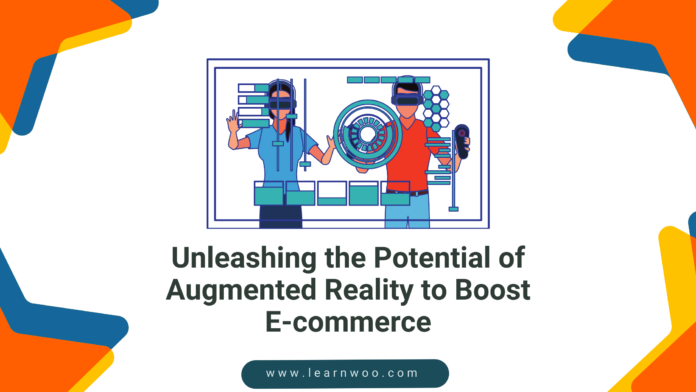Last updated - February 15, 2024
Augmented reality (AR) is gradually transforming the e-commerce space. It is no longer just a futuristic concept but a present-day tool revolutionizing how we shop online.
Interestingly, the adoption of AR is growing at an incredible pace. Statistics reveal that the number of devices equipped with AR capabilities is soaring. By 2024, it is anticipated to reach a staggering 1.7 billion by 2024.


This surge underscores the immense potential of augmented reality to boost e-commerce. It offers unparalleled opportunities for businesses to enhance customer engagement and drive growth.
As we delve deeper into this transformative technology, I’ll be sharing how AR is currently being utilized in e-commerce and the remarkable benefits it brings to the online shopping experience.
Let’s begin our exploration.
An Introduction to Augmented Reality in E-commerce
Augmented reality, at its core, is about enriching the real world with digital information and media, such as 3D models and videos. It overlays this information in the user’s environment in real-time.
Initially perceived as a novelty, AR has rapidly evolved into a valuable tool in various sectors, particularly e-commerce. AR now offers a unique opportunity to bridge the gap between the digital and physical shopping experiences.
Just as AI continues to impact e-commerce, many brands have adopted AR to provide immersive and interactive experiences to their customers.
For instance, furniture retailers use AR to help customers visualize how a piece of furniture would look in their space before making a purchase.


Fashion brands are also leveraging AR for virtual try-ons, allowing customers to see how clothes and accessories would look on them.


These applications not only enhance user engagement but also provide a tangible sense of the product, which was previously possible only in physical stores.
In short, AR has proved itself to be an invaluable addition to any e-commerce marketing strategy. While ambassador marketing can create brand awareness, AR plays a different role. It engages prospective customers by providing them with a lifelike demonstration of how a product can meet their needs.
How AR Enhances Online Shopping Experiences
Augmented Reality (AR) is redefining the way customers interact with products online. The technology allows customers to engage with products in a more meaningful way, significantly enhancing the online shopping experience.
Interactive Product Demonstrations
AR facilitates interactive product demonstrations. It allows customers to explore features and functionalities dynamically and engagingly.
This immersive approach not only captivates customer interest. It also aids in better understanding the product, leading to more informed purchasing decisions.
Personalization
Personalization is another key advantage of AR. The technology allows customers to visualize products in their environment or see how items look on them.
This tailored shopping experience creates a deeper connection and often results in higher customer satisfaction.
Reduced Product Returns
Lastly, AR’s impact on reducing product returns is significant. It provides customers with a realistic preview of products.
This way, it minimizes the discrepancies between expectation and reality, which is a common cause of returns in online shopping.
This strategic approach doesn’t only benefit customers by ensuring satisfaction; it also aids retailers in reducing the costs and logistics associated with returns.
Practical Ways to Implement AR in E-commerce
Implementing augmented reality (AR) in e-commerce is a strategic move that can significantly elevate the shopping experience.
Here’s a concise list of steps for businesses to effectively integrate AR:
Identify Suitable Products for AR Implementation
Start by selecting products that would greatly benefit from AR visualization, such as furniture or apparel. This step is crucial as it involves choosing items where AR can significantly enhance the customer’s understanding and perception. thereby decrease in return rates due to sizing or style issues.
Choose the Right AR Platform
Research and opt for an AR platform that aligns with your e-commerce needs. Factors to consider include compatibility with your existing e-commerce setup, scalability for future growth, and user-friendliness. These ensure smooth integration and a seamless customer experience.
Develop a User-Centric AR Experience
The AR feature should be designed to be intuitive and easy to navigate. The AR experience must be integrated seamlessly into the customer’s online shopping journey.
Integrate a service desk software to create one point of contact between the customer and the company. The focus should be on simplicity and effectiveness to enhance user engagement.
Optimize for Mobile and Web Platforms
Ensure the AR experience is accessible and performs consistently across various devices, especially smartphones. Prioritizing mobile optimization and thoroughly testing features across different browsers and operating systems is crucial for guaranteeing a consistent user experience.
Focus on High-Quality, Realistic AR Content
Invest in creating high-quality 3D models and realistic visualizations. Maintaining the accuracy and appeal of AR content is key to maintaining an engaging and effective user experience.
Educate Customers About AR Features
Write a blog or develop other educational materials to assist customers in using the AR features. Implementing marketing campaigns and harnessing the power of digital PR solutions to promote and explain the AR experience are strategic moves. These can play a significant role in encouraging adoption.
Measure and Analyze User Engagement
Utilize analytics tools to track customer interactions with the AR features. Analyzing this data helps in understanding user behavior and preferences. This is vital for making informed improvements to the AR experience.
Address Technical Challenges Proactively
Anticipate and prepare for potential technical challenges, such as device compatibility or bandwidth requirements. Having a responsive support team can greatly assist in resolving customer issues swiftly.
Again, technology can be implemented effectively to enhance CX. Any one of the top AI-based e-commerce chatbots reviewed in the Attrock guide can be integrated into your website to provide relevant and timely responses to your users.
Plan for Scalability and Future Enhancements
Keep your AR implementation adaptable for future advancements in the technology. Staying up-to-date with emerging trends and features can provide opportunities to further enhance the customer experience.
Evaluate ROI and Continuously Improve
Regularly assess the return on investment of the AR features for your e-commerce business. Also, seek continuous improvement based on customer feedback and technological advancements. This ensures that the experience remains engaging and beneficial.
By following these steps and focusing on a user-centric approach, we can see the huge potential of augmented reality to boost e-commerce. This can help enhance customer engagement and drive sales.
Conclusion
In exploring the potential of augmented reality to boost e-commerce, I’ve shared how AR is not just a technological advancement but a pivotal tool in reshaping the online shopping experience.
From enhancing customer engagement through interactive and personalized shopping experiences to reducing product returns, AR is setting a new standard in e-commerce.
As we’ve seen, the practical implementation of AR in e-commerce involves strategic planning, focusing on user experience, and making continuous improvements.
By taking these steps, businesses can unlock the true potential of AR, not only to revolutionize their online presence but also to foster deeper connections with their customers.
The future of e-commerce is undeniably intertwined with advancements like AR. As technology continues to evolve, the opportunities for you to scale your e-commerce business will only expand.
This is good news for those ready to embrace these changes. The journey toward a more engaging, efficient, and profitable e-commerce experience is just beginning!
FAQs
What is augmented reality (AR)?
Augmented reality (AR) is a technology that mixes digital elements, like 3D models or videos, with the real world. It lets you see digital information overlaid on your physical surroundings through devices like smartphones or AR glasses.
How does AR benefit e-commerce?
AR enhances the online shopping experience by allowing customers to interact with products virtually. It lets them see how products would look in their space or on themselves before making a purchase, leading to more informed buying decisions and reducing the chances of returns.
Do I need special equipment to use AR for online shopping?
Not necessarily. Many e-commerce platforms offer AR features that work on smartphones or tablets, so you can use them with devices you already have.
Can you give examples of how AR is used in e-commerce?
AR is used for things like virtual furniture placement, where you can see how a piece of furniture would fit in your room, or virtual try-ons for fashion, where you can see how clothes would look on you before buying. These applications make online shopping more immersive and engaging.











